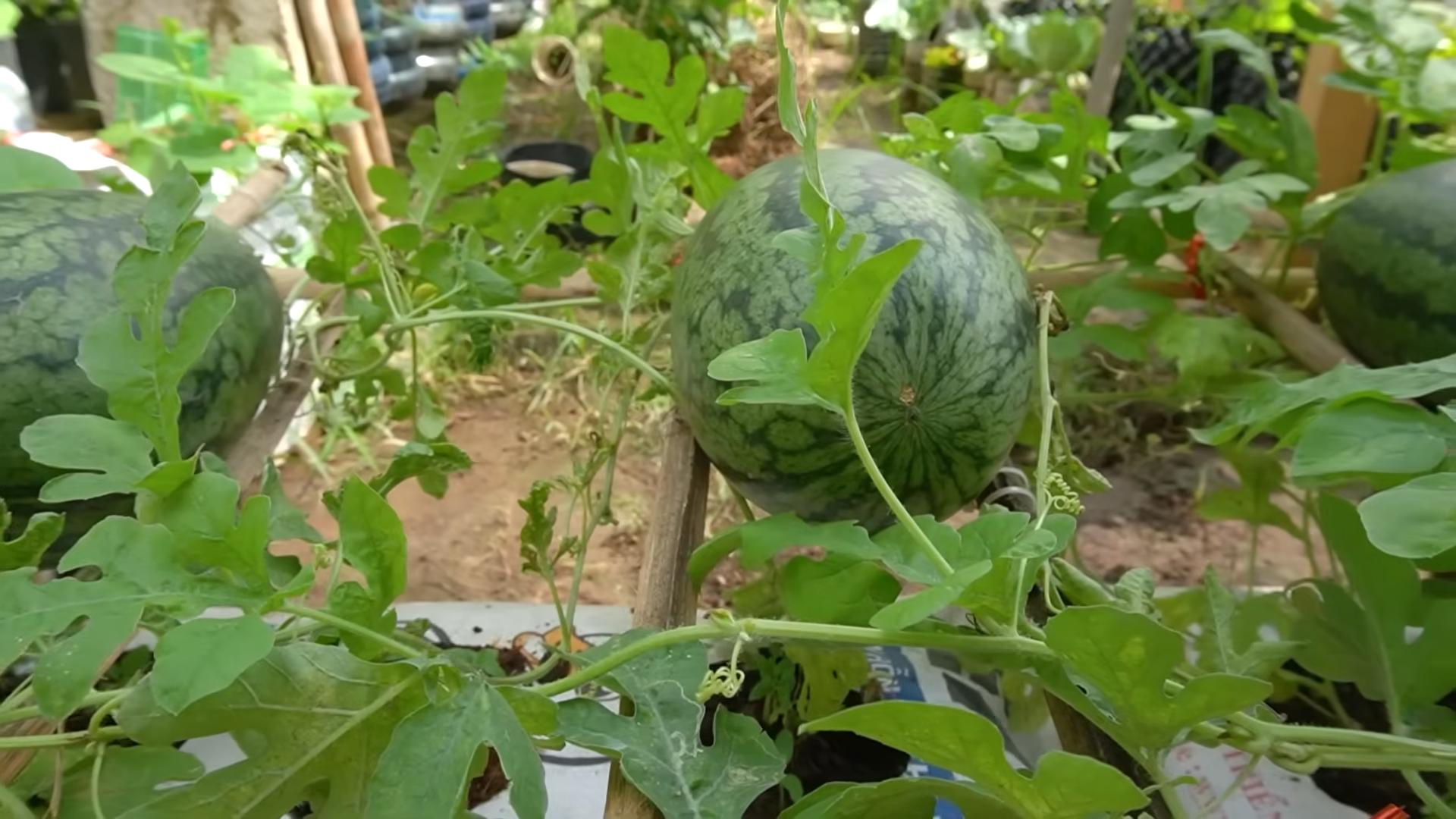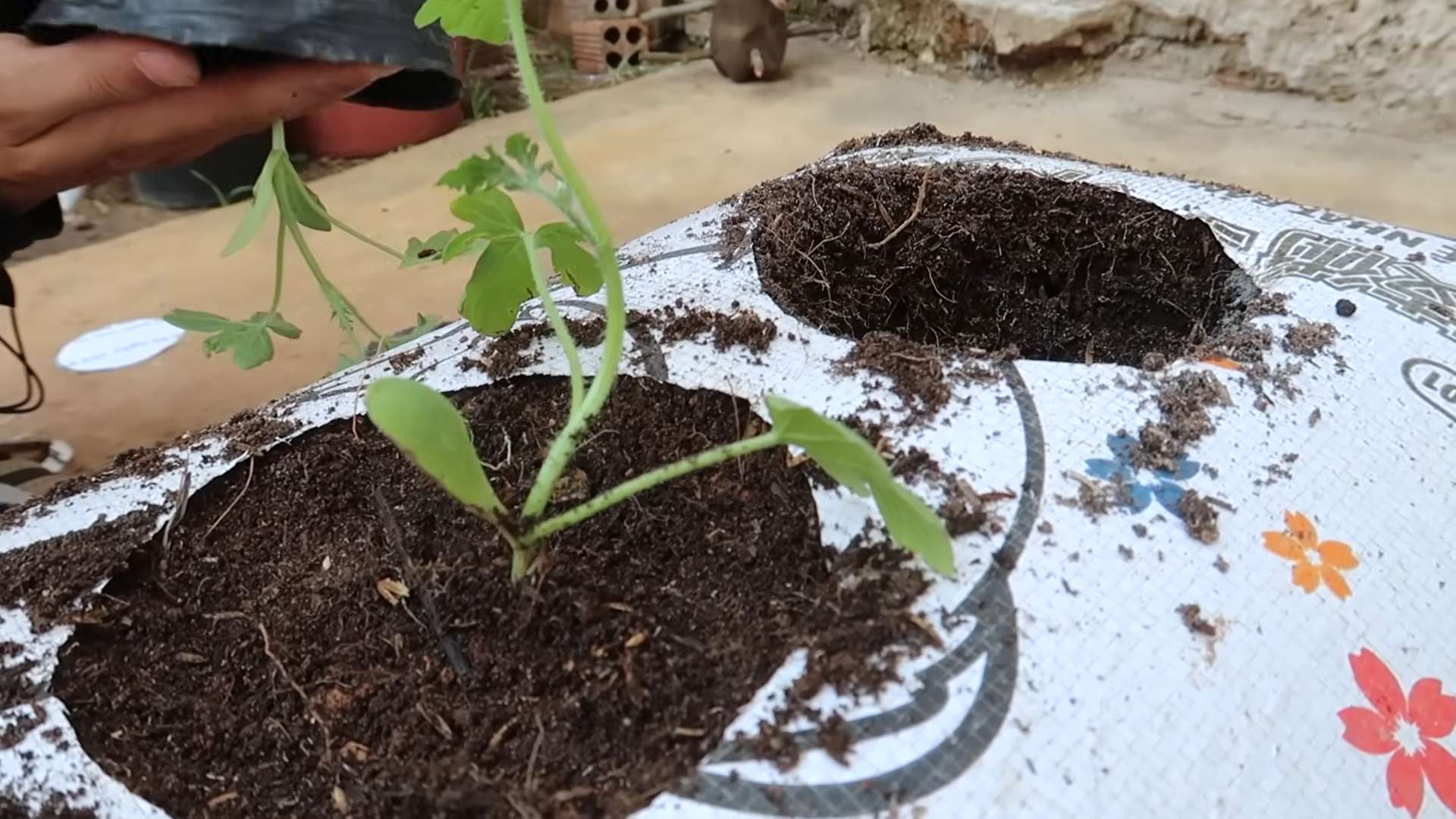Growing Watermelons Without Land? Absolutely! Imagine sinking your teeth into a juicy, homegrown watermelon, bursting with flavor, even if you don’t have a sprawling backyard. Sounds like a dream, right? Well, it’s a dream within reach! For centuries, gardeners have been innovating, finding clever ways to cultivate delicious produce in limited spaces. From ancient rooftop gardens in bustling cities to modern-day balcony farms, the spirit of resourceful gardening has always thrived.
But why should you consider growing watermelons without land? In today’s world, space is a premium. Many of us live in apartments, condos, or homes with small yards. This doesn’t mean we have to miss out on the joy of fresh, homegrown food. Plus, let’s be honest, store-bought watermelons can sometimes be a gamble – bland, mealy, or just not quite ripe. With a few simple DIY tricks and hacks, you can cultivate your own sweet, satisfying watermelons, tailored to your taste and grown with love. I’m going to show you how to make it happen!
This article is packed with practical tips and step-by-step instructions to help you successfully grow watermelons in containers, raised beds, or even hanging baskets. We’ll cover everything from choosing the right variety to providing the perfect support system for your growing melons. Get ready to unleash your inner gardener and enjoy the sweet taste of success, no matter how small your space may be!

Growing Watermelons Vertically: A Space-Saving DIY Guide
Hey there, fellow gardening enthusiasts! Ever dreamed of sinking your teeth into a juicy, homegrown watermelon but thought you didn’t have the space? Well, I’m here to tell you that you absolutely can! Forget sprawling vines taking over your entire yard. We’re going vertical! This guide will walk you through how to grow watermelons without land, using a trellis system. It’s easier than you think, and the results are incredibly rewarding.
Why Grow Watermelons Vertically?
Before we dive in, let’s talk about why this method is so awesome:
* Space Saving: This is the biggest benefit! Vertical gardening lets you grow watermelons even in small yards, balconies, or patios.
* Better Air Circulation: Elevated vines get better airflow, reducing the risk of fungal diseases.
* Easier Harvesting: No more bending and searching under a tangle of leaves. Your watermelons will be hanging right there, ready to be picked.
* Pest Control: It’s easier to spot and manage pests when your plants are off the ground.
* Aesthetic Appeal: Let’s be honest, a watermelon-covered trellis looks pretty darn cool!
What You’ll Need
Okay, let’s gather our supplies. Here’s what you’ll need to get started:
* Watermelon Seeds or Seedlings: Choose a smaller variety like Sugar Baby, Bush Sugar Baby, or Golden Midget. These are better suited for vertical growing. I personally love Sugar Baby for its sweetness and manageable size.
* Large Containers: You’ll need containers that are at least 20 gallons in size. The bigger, the better! Watermelons are heavy feeders and need plenty of room for their roots. I recommend using durable plastic containers with drainage holes.
* High-Quality Potting Mix: Don’t skimp on this! Use a well-draining potting mix rich in organic matter. I like to amend mine with compost and perlite for extra drainage.
* Trellis: A sturdy trellis is essential. It needs to be strong enough to support the weight of the mature vines and watermelons. You can use a metal trellis, a wooden trellis, or even a repurposed fence panel. Make sure it’s at least 6 feet tall.
* Plant Ties or Soft Twine: You’ll need these to gently secure the vines to the trellis. Avoid using wire, as it can damage the stems.
* Support Slings: As the watermelons grow, they’ll need extra support. You can use old t-shirts, pantyhose, or even specialized fruit slings.
* Fertilizer: Watermelons are heavy feeders, so you’ll need a balanced fertilizer. Look for one with a higher phosphorus content to encourage fruit production.
* Watering Can or Hose: Essential for keeping your plants hydrated.
* Gloves: To protect your hands.
* Pruning Shears: For trimming the vines.
Step-by-Step Instructions: Planting and Training Your Watermelons
Now for the fun part! Let’s get those watermelons growing.
1. Prepare Your Containers: Fill your containers with the high-quality potting mix, leaving a few inches of space at the top.
2. Plant Your Seeds or Seedlings: If you’re starting from seeds, sow them directly into the containers, following the instructions on the seed packet. If you’re using seedlings, gently remove them from their pots and plant them in the center of the containers.
3. Water Thoroughly: Water the soil well after planting, making sure the water drains out of the drainage holes.
4. Position Your Trellis: Place the trellis behind the containers, making sure it’s securely anchored. You can use stakes or tie it to a fence for extra stability.
5. Train the Vines: As the watermelon vines grow, gently guide them towards the trellis and secure them with plant ties or soft twine. Space the ties a few inches apart to provide adequate support. I usually start training them when they’re about a foot long.
6. Prune Regularly: Watermelons produce a lot of side shoots, which can take energy away from fruit production. Prune these side shoots regularly, leaving only the main vine and a few healthy leaves. I usually prune them back to about 6 inches long.
7. Fertilize Regularly: Watermelons need regular feeding to produce large, juicy fruits. Fertilize them every two weeks with a balanced fertilizer, following the instructions on the fertilizer package.
8. Water Consistently: Watermelons need consistent moisture, especially during hot weather. Water them deeply whenever the top inch of soil feels dry. Avoid overwatering, as this can lead to root rot.
9. Provide Support for the Fruits: As the watermelons grow, they’ll need extra support to prevent them from breaking off the vine. When the fruits are about the size of a softball, create slings using old t-shirts, pantyhose, or specialized fruit slings. Gently cradle the watermelons in the slings and tie them to the trellis. This will distribute the weight and prevent the vines from snapping.
Supporting the Growing Watermelons
This is a crucial step, so let’s break it down further:
1. Choose Your Sling Material: Old t-shirts, pantyhose, burlap sacks, or even store-bought fruit slings work well. The material should be soft and breathable to avoid damaging the fruit.
2. Create the Sling: If using a t-shirt or pantyhose, cut a section large enough to comfortably hold the watermelon. You want it to be like a little hammock.
3. Position the Sling: Gently lift the watermelon and place the sling underneath it, ensuring the weight is evenly distributed.
4. Secure the Sling to the Trellis: Tie the ends of the sling securely to the trellis using plant ties or twine. Make sure the sling is snug but not too tight, allowing the watermelon to continue growing.
5. Monitor and Adjust: As the watermelon grows larger, you may need to adjust the sling to provide more support. Check the ties regularly to ensure they’re still secure.
Dealing with Pests and Diseases
Even in a vertical garden, pests and diseases can still be a problem. Here’s how to handle them:
1. Regular Inspection: Check your plants regularly for signs of pests or diseases. Look for things like aphids, spider mites, powdery mildew, or wilting leaves.
2. Organic Pest Control: If you find pests, try using organic pest control methods like insecticidal soap, neem oil, or diatomaceous earth.
3. Fungicides: If you see signs of fungal diseases, use a fungicide specifically designed for vegetables.
4. Good Air Circulation: Ensure good air circulation around your plants by pruning regularly and spacing them properly.
5. Remove Infected Leaves: If you find any infected leaves, remove them immediately to prevent the disease from spreading.
Harvesting Your Watermelons
The moment we’ve all been waiting for! Here’s how to tell when your watermelons are ripe:
1. Check the Tendril: The tendril closest to the watermelon should be brown and dry.
2. Thump Test: Give the watermelon a gentle thump. A ripe watermelon will sound hollow.
3. Ground Spot: The spot where the watermelon rests on the ground (or in our case, the sling) should be yellow or cream-colored.
4. Days to Maturity: Check the seed packet for the days to maturity. This will give you a general idea of when your watermelons will be ready to harvest.
Once your watermelons are ripe, carefully cut them from the vine, leaving a few inches of stem attached. Then, get ready to enjoy the fruits (literally!) of your labor.
Troubleshooting Common Problems
Even with the best care, you might encounter a few challenges. Here are some common problems and how to fix them:
* Yellowing Leaves: This could be a sign of overwatering, underwatering, or nutrient deficiency. Check the soil moisture and fertilize accordingly.
* Blossom End Rot: This is caused by a calcium deficiency. Add calcium to the soil or use a calcium-rich fertilizer.
* Poor Fruit Set: This could be due to lack of pollination. You can hand-pollinate the flowers by transferring pollen from the male flowers to the female flowers using a small brush.
* Small Fruits: This could be due to lack of nutrients or water. Fertilize and water regularly.
* Splitting Fruits: This is usually caused by inconsistent watering. Water regularly and avoid letting the soil dry out completely.
Choosing the Right Watermelon Variety
As I mentioned earlier, smaller watermelon varieties are

Conclusion
So, there you have it! Growing watermelons without land might seem like a horticultural impossibility, but with a little ingenuity and the right approach, you can absolutely enjoy the sweet taste of homegrown watermelon, even if you’re short on space. This DIY trick isn’t just about circumventing the limitations of a traditional garden; it’s about embracing a more sustainable and adaptable way of cultivating your own food.
Why is this a must-try? Because it opens up the possibility of fresh, delicious watermelons to apartment dwellers, balcony gardeners, and anyone with limited yard space. Imagine the satisfaction of harvesting a juicy watermelon from your own patio, knowing you nurtured it from seed to fruit, all without a sprawling garden plot. Beyond the sheer convenience, this method also allows for better control over the growing environment. You can easily move your container to optimize sunlight exposure, protect it from harsh weather, and monitor soil conditions more effectively.
But don’t stop there! This method is ripe for experimentation. Consider these variations to personalize your watermelon-growing journey:
* Vertical Trellising: Train your watermelon vines to climb a trellis for even greater space efficiency. This also improves air circulation, reducing the risk of fungal diseases.
* Grafted Watermelons: Grafting watermelon scions onto more vigorous rootstocks can boost disease resistance and overall plant health, especially in challenging climates.
* Different Varieties: While smaller varieties like Sugar Baby are ideal, don’t be afraid to experiment with other types. Just be mindful of their size and adjust your container accordingly.
* Companion Planting: Incorporate companion plants like basil or marigolds around your watermelon container to deter pests and attract beneficial insects.
* Hydroponics: For the more adventurous gardener, explore hydroponic watermelon cultivation for even greater control over nutrient delivery and water usage.
Ultimately, growing watermelons without land is a testament to the power of innovation and a reminder that gardening can be accessible to everyone. It’s a rewarding experience that connects you to the natural world, provides fresh produce, and adds a touch of green to your living space.
We wholeheartedly encourage you to give this DIY trick a try. It’s easier than you might think, and the results are incredibly satisfying. Don’t be afraid to get your hands dirty, experiment with different techniques, and learn from your experiences.
And most importantly, we want to hear about your watermelon-growing adventures! Share your photos, tips, and challenges in the comments below. Let’s build a community of urban watermelon growers and inspire others to embrace the joy of homegrown produce, no matter how small their space may be. Let us know what kind of container you used, what variety of watermelon you grew, and any unique challenges you faced. Your insights could be invaluable to other aspiring gardeners.
Remember, the key to success is patience, observation, and a willingness to learn. With a little effort, you’ll be enjoying the sweet taste of homegrown watermelon in no time. Happy growing!
Frequently Asked Questions (FAQ)
What is the best type of container to use for growing watermelons without land?
The ideal container should be large enough to accommodate the watermelon’s extensive root system and provide adequate drainage. A minimum of 20-25 gallons is recommended, but larger is generally better. Consider using a durable plastic container, a fabric grow bag, or even a repurposed barrel. Ensure the container has drainage holes to prevent waterlogging, which can lead to root rot. Dark-colored containers can absorb more heat, which can be beneficial in cooler climates, but may require more frequent watering in hotter regions. Fabric grow bags offer excellent aeration and drainage, promoting healthy root growth.
What type of soil should I use for container-grown watermelons?
Watermelons need well-draining, nutrient-rich soil. A good potting mix specifically formulated for vegetables is ideal. Avoid using garden soil, as it can become compacted in containers and hinder drainage. You can also create your own mix by combining equal parts of peat moss or coconut coir, perlite or vermiculite, and compost. Adding slow-release fertilizer to the mix will provide a steady supply of nutrients throughout the growing season. Regularly amend the soil with compost or other organic matter to maintain its fertility.
How much sunlight do watermelons need when grown in containers?
Watermelons require at least 6-8 hours of direct sunlight per day to thrive. Choose a location that receives ample sunlight throughout the growing season. If you live in a particularly hot climate, some afternoon shade may be beneficial to prevent the plants from overheating. If natural sunlight is limited, consider supplementing with grow lights. Rotate the container regularly to ensure even sunlight exposure on all sides of the plant.
How often should I water my container-grown watermelons?
Watermelons are thirsty plants, especially when grown in containers. Water deeply and regularly, especially during hot, dry weather. Check the soil moisture daily and water when the top inch feels dry to the touch. Avoid overwatering, as this can lead to root rot. A good rule of thumb is to water until excess water drains from the bottom of the container. Consider using a soaker hose or drip irrigation system to provide consistent moisture directly to the roots.
How do I fertilize my container-grown watermelons?
Watermelons are heavy feeders and require regular fertilization. Use a balanced fertilizer (e.g., 10-10-10) early in the growing season to promote vegetative growth. Once the plants start to flower, switch to a fertilizer higher in phosphorus and potassium (e.g., 5-10-10) to encourage fruit development. Follow the instructions on the fertilizer label for application rates. You can also supplement with liquid seaweed or fish emulsion for added nutrients. Avoid over-fertilizing, as this can lead to excessive foliage growth at the expense of fruit production.
How do I pollinate my watermelons if I don’t have bees?
Watermelons require pollination to produce fruit. If you don’t have bees or other pollinators in your area, you may need to hand-pollinate the flowers. Identify the male and female flowers. The female flowers have a small, immature watermelon at the base of the flower, while the male flowers do not. Use a small paintbrush or cotton swab to collect pollen from the male flower and transfer it to the stigma of the female flower. Hand-pollinate in the morning, when the flowers are most receptive.
How do I support the weight of the watermelons as they grow?
As the watermelons grow larger, they may need support to prevent the vines from breaking. Use slings made from pantyhose, netting, or fabric to support the fruit. Tie the slings to a sturdy trellis or support structure. This will help distribute the weight of the watermelon and prevent it from falling off the vine prematurely.
When do I harvest my container-grown watermelons?
Determining when a watermelon is ripe can be tricky. Look for these signs:
* The tendril closest to the fruit turns brown and dry.
* The underside of the watermelon (where it rests on the ground) turns from white to yellow.
* The watermelon sounds hollow when you thump it.
* The skin becomes dull and loses its shine.
Use a sharp knife to cut the watermelon from the vine, leaving a few inches of stem attached.
What are some common pests and diseases that affect container-grown watermelons?
Common pests include aphids, squash bugs, and vine borers. Diseases include powdery mildew, fusarium wilt, and anthracnose. Regularly inspect your plants for signs of pests or diseases. Treat infestations with insecticidal soap or neem oil. Prevent diseases by providing good air circulation, avoiding overwatering, and using disease-resistant varieties.
Can I grow watermelons in containers indoors?
While it’s possible to grow watermelons indoors, it can be challenging. You’ll need a very sunny location or strong grow lights to provide adequate light. You’ll also need to hand-pollinate the flowers. Indoor growing can be more susceptible to pests and diseases due to the controlled environment. It’s generally easier and more successful to grow watermelons outdoors in containers.




Leave a Comment